
Hippocampus bargibanti, also known as Bargibant's seahorse or the pygmy seahorse, is a seahorse of the family Syngnathidae found in the central Indo-Pacific area.

The West African seahorse is a species of fish in the family Syngnathidae. It is found in the eastern central Atlantic Ocean off Angola, Benin, Ivory Coast, Gambia, Ghana, Guinea, Liberia, Nigeria, São Tomé and Príncipe, Senegal, and Sierra Leone, as well as the Canary Islands. Although there have been no records from Algeria since Guichenot said that the type was collected at Béjaïa in the 1850s, but the location given may be an error.
Hippocampus angustus, commonly known as the narrow-bellied seahorse, western Australian seahorse, or western spiny seahorse, is a species of marine fish of the family Syngnathidae. It is found in waters off of Australia, from Perth to Hervey Bay, and the southern portion of Papua New Guinea in the Torres Strait. It lives over soft-bottom substrates, adjacent to coral reefs, and on soft corals at depths of 3–63 metres (9.8–206.7 ft). It is expected to feed on small crustaceans, similar to other seahorses. This species is ovoviviparous, with males carrying eggs in a brood pouch before giving birth to live young. This type of seahorse is monogamous in its mating patterns. The males only fertilize one female's eggs for the mating season because of the population distribution. While some seahorses can be polygamous because they are denser in population, this type of seahorse is more sparsely distributed and the cost of reproduction is high. Therefore, the risk to reproduce due to predatory and distributary factors limits this breed to one mate, often finding the same mate season after season.

Barbour's seahorse is a species of fish of the family Syngnathidae.

The knobby seahorse, also known as the short-headed seahorse or short-snouted seahorse, is a species of marine fish of the family Syngnathidae. It inhabits coastal waters in southwestern and southeastern Australia, from Gregory to Bremer Bay, and from Denial Bay to Newcastle.

Hippocampus coronatus, commonly known as the high-crowned seahorse or crowned seahorse, is a species of fish of the family Syngnathidae. It is endemic to the Pacific coastal waters of Japan, where it lives among Zostera seagrasses. It can grow to lengths of 10.8 centimetres (4.3 in), but is more commonly 6 centimetres (2.4 in). Individuals feed mainly on small crustaceans such as gammarid amphipods and copepods, although this can vary by size, with smaller individuals consuming copepods while larger individuals feed on amphipods and mysids. This species is ovoviviparous, with males brooding eggs in a brood pouch before giving birth to live young. Breeding season occurs from June to November, with females and males reaching sexual maturity at 6.9 centimetres (2.7 in) and 7.3 centimetres (2.9 in) respectively. Male brood size ranges from 12–46. The International trade in this species has been monitored through Appendix II of the CITES licensing system since 2004 and a minimum size of 10 centimetres (3.9 in) applies to traded specimens.
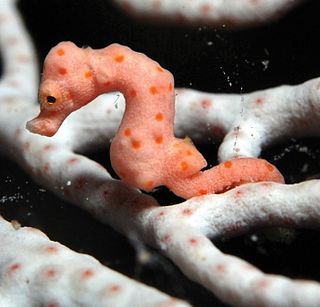
Hippocampus denise, also known as Denise's pygmy seahorse or the yellow pygmy seahorse, is a seahorse of the family Syngnathidae native to the western Pacific.

Hippocampus fisheri, commonly known as Fisher's seahorse, or the Hawaiian seahorse, is a species of fish of the family Syngnathidae. It is known from the Hawaiian Islands, although previous misidentifications indicated species occurrences in Australia and New Caledonia. Habitat preferences are unknown, but it has been found far away from shore and at depths greater than 100 metres (330 ft). Feeding habits are also unknown, but individuals are expected to feed on small crustaceans similar to other seahorses. Hippocampus fisheri is one out of the three species of Hippocampus genus found in the Hawaiian islands. They are also expected to be ovoviviparous, with males carrying eggs in a brood pouch before giving birth to live young. Individuals can grow to lengths of 8 centimetres (3.1 in). The specific name and the common name honour "Walter V. Fisher” of Stanford University. There was a Walter Kenrick Fisher who was Jordan and Evermann's colleague at Stanford and the “V” is assumed to be a typo.

Hippocampus guttulatus, commonly known as the long-snouted seahorse and in Great Britain as the spiny seahorse, is a marine fish belonging to the family Syngnathidae, native from the northeast Atlantic, including the Mediterranean.
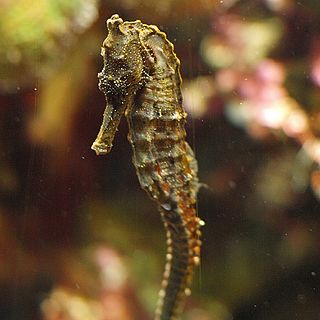
The great seahorse, also known as Kellogg's seahorse is a species of fish in the family Syngnathidae. It is one of the largest of the 54 species of seahorse.
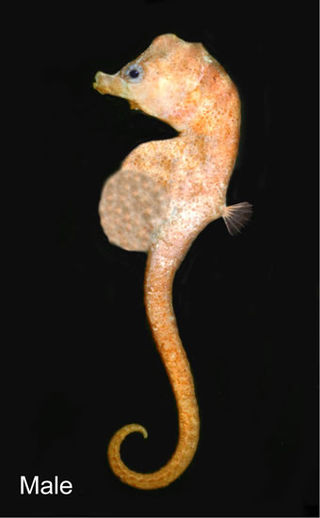
The bullneck seahorse is a pygmy seahorse in the genus Hippocampus. This seahorse has never been found in the wild, and little is known about its natural habitat. The only known specimens were collected on the coast of Eden, Australia. It is thought to live in sand beds at the bottom of the ocean, possibly wrapping its prehensile tail around gorgonian corals. The seahorse is among the 25 “most wanted lost” species that are the focus of Global Wildlife Conservation's “Search for Lost Species” initiative.

The slender seahorse or longsnout seahorse is a species of fish in the family Syngnathidae that usually inhabits subtropical regions.

Shiho's seahorse or Sindo's Seahorse, painted seahorse is a species of fish in the family Syngnathidae. It is endemic to the Pacific coastal waters of Japan. This species reaches a length of ca. 8 cm. It was listed by the IUCN Red List as Vulnerable in 1996 and Data Deficient in 2003, but was later reclassified as Least Concern. The specific name honours Michitaro Sindo, who was originally from Yamaguchi and who was assistant curator of fishes at Stanford University.
The zebra seahorse is a species of fish in the family Syngnathidae. It is endemic to northern Australia.

The spiny seahorse, also referred to as the thorny seahorse, is a small marine fish in the family Syngnathidae, native to the Indo-Pacific area. It is classified as a Vulnerable species by the IUCN.
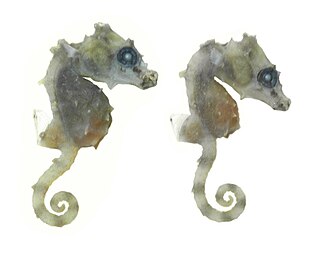
Satomi's pygmy seahorse is the smallest known seahorse in the world with an average length of 13.8 millimetres (0.54 in) and an approximate height of 11.5 millimetres (0.45 in).
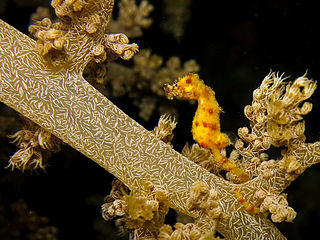
Hippocampus waleananus, the Walea soft coral pygmy seahorse, was regarded as a synonym of Hippocampus satomiae, Lourie & Kuiter, 2008, however, some taxonomists suggested this name should be valid. The species was described in 2009 from a single specimen which was found close to the island Walea. This species is endemic to the Togian Islands in Indonesia, and is associated with specific soft corals.

Hippocampus pontohi, also known as Pontoh's pygmy seahorse or the weedy pygmy seahorse, is a seahorse of the family Syngnathidae native to the central Indo-pacific. Named after Hence Pontoh, the Indonesian dive guide from Bunaken (Manado) who first brought these pygmy seahorses to attention.
Hippocampus debelius, commonly known as the softcoral seahorse, is a species of marine fish of the family Syngnathidae. It is known from only two specimens collected from the Gulf of Suez in the Red Sea, at depths of 15–30 metres (49–98 ft). Individuals were found associated with soft corals. Although little is known of this species, it is expected to feed on crustaceans, similar to other seahorses. It is also expected to be ovoviviparous, with males carrying eggs in a brood pouch before giving birth to live young.
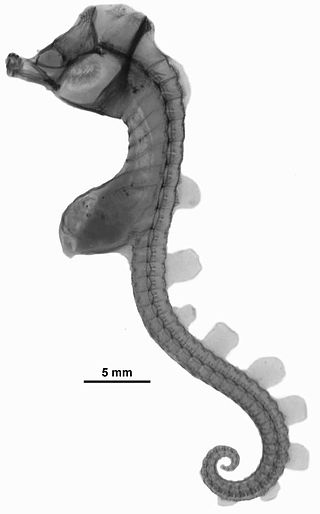
The paradoxical seahorse is a small seahorse in the genus Hippocampus. The only known specimen was captured in 1995 and remained unnoticed in a museum until 2006.

















